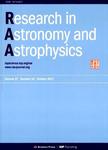Double hard X-ray peaks in RHESSI flares as evidence of chromospheric evaporation and implications for modifying the Neupert effect
Double hard X-ray peaks in RHESSI flares as evidence of chromospheric evaporation and implications for modifying the Neupert effect作者机构:Purple Mountain Observatory Chinese Academy of Sciences Nanjing 210008 China
出 版 物:《Research in Astronomy and Astrophysics》 (天文和天体物理学研究(英文版))
年 卷 期:2009年第9卷第10期
页 面:1155-1164页
核心收录:
学科分类:081702[工学-化学工艺] 07[理学] 08[工学] 0817[工学-化学工程与技术] 070401[理学-天体物理] 0704[理学-天文学]
基 金:supported by the National Natural Science Foundation of China (Grant Nos.10773031 and 10833007) the Ministry of Science and Technology of China(Grant No. 2006CB806302) by the CAS project KJCX2-YW-T04
主 题:Sun flares -- Sun X-rays, gamma-rays
摘 要:Among the RHESSI flare samples, we concentrated on a kind of flare that presents two successive peaks (that is, it presents both an impulsive phase and a gradual phase) in 12 - 25 keV light curves. Taking the C1.4 flare on 2002 August 12 as an example, we studied the light curves, spectra, and images in detail. Making full use of the capabilities of RHESSI, we showed some evidence to support the expected causal relationship between these two peaks; the first peak is mainly nonthermal, while the second peak is mainly thermal; the energy carried by nonthermal electrons during the first peak seems to be comparable to the thermal energy of the second peak. The morphologies of X-ray images and their evolutions provide additional evidence for this causality. We conclude that two such peaks in the 12 - 25 keV light curve are good evidence for the chromospheric evaporation. However, the maximum time of the second peak is later than the end time of the first peak, suggesting that for some events, a modification of the traditional Neupert effect could be necessary by inclusion of a time delay, which might be partly related to the filling of the loop by evaporated material.



